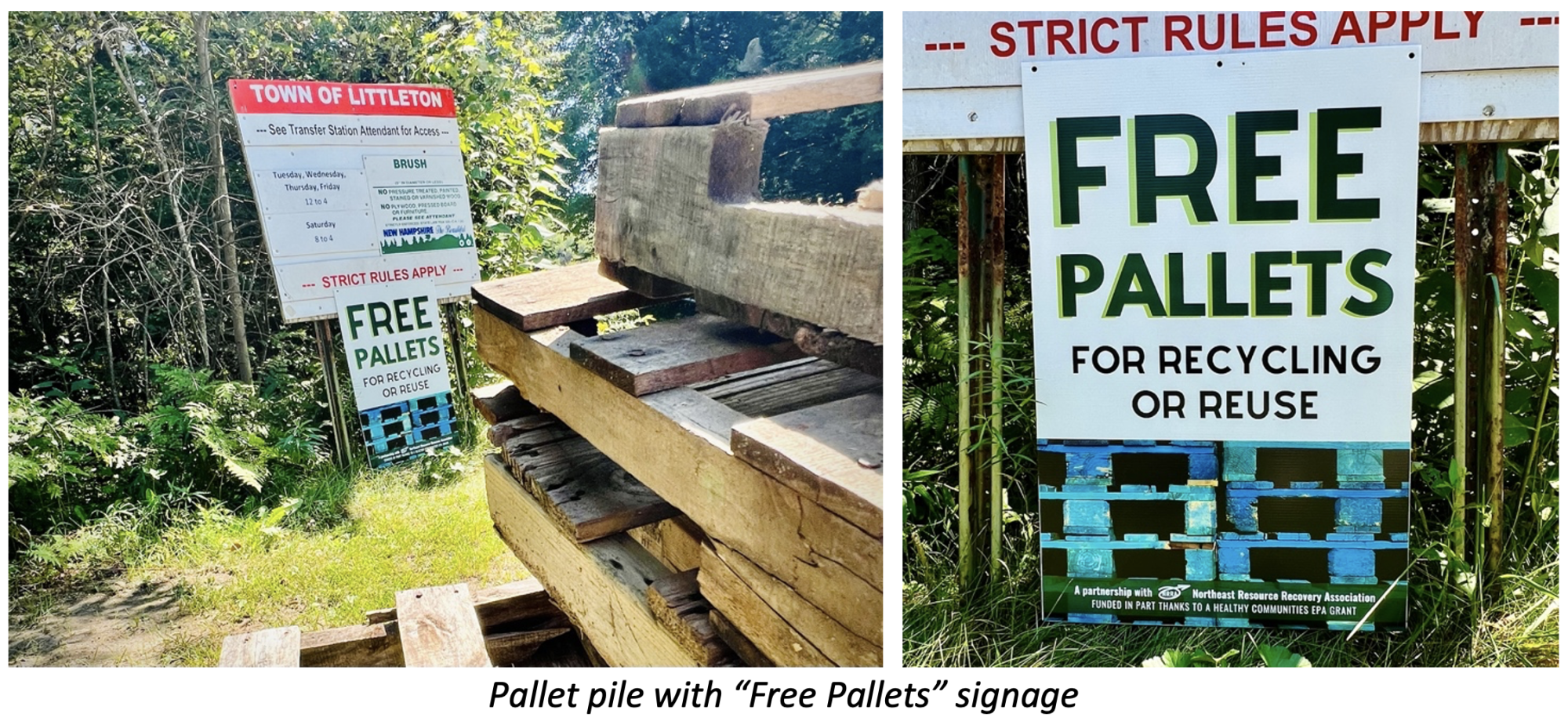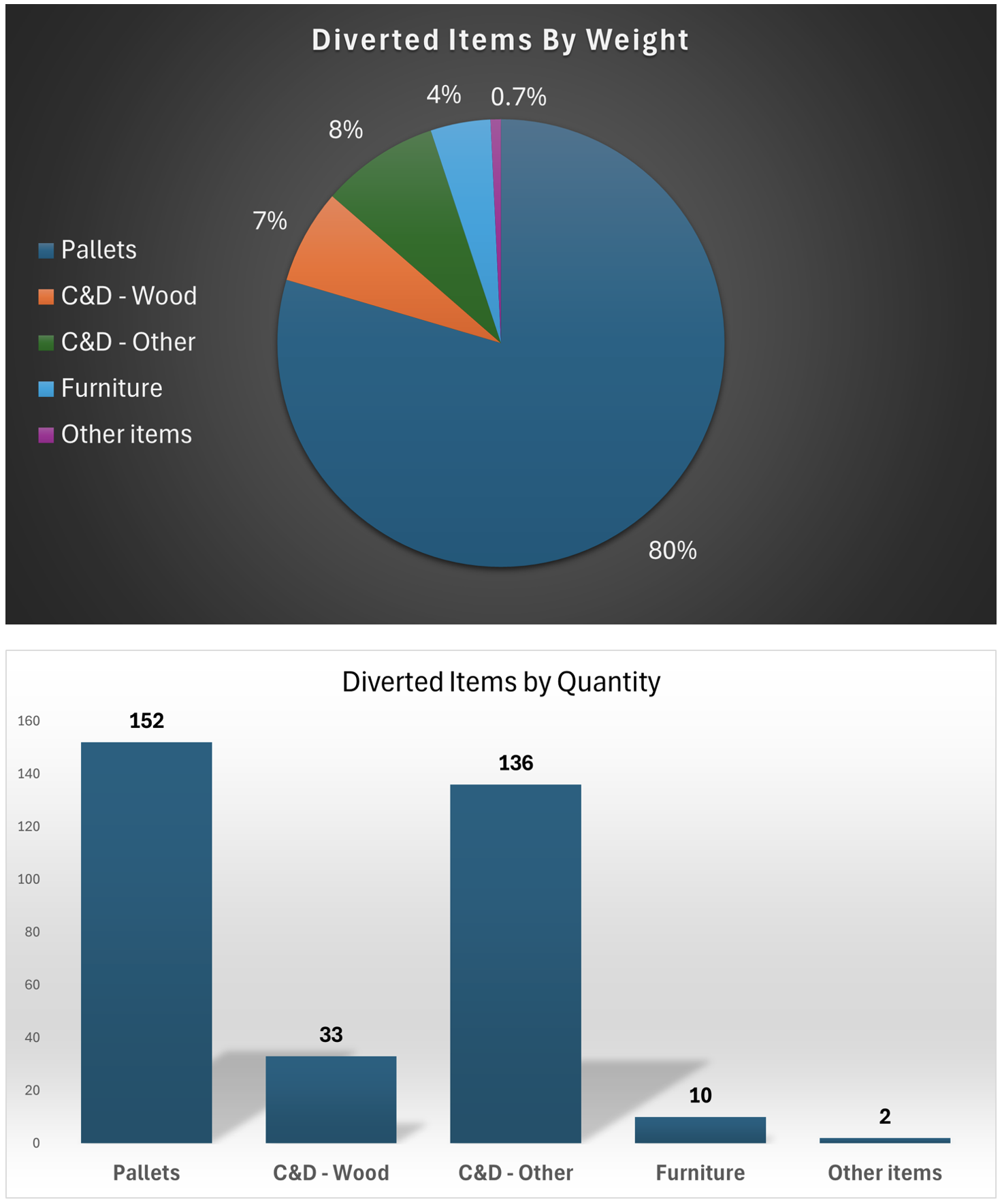Littleton C&D and Bulky Waste Diversion Case Study
The Littleton, NH Transfer Station conducted a pilot program to increase diversion of construction and demolition debris (C&D) and bulky waste from being landfilled through residential reuse of wood, doors, windows, and other reusable building items, as well as bulky waste such as furniture and pallets. The pilot program lasted from July 9th to August 14th, 2024 with technical assistance from the Northeast Resource Recovery Association (NRRA).
Since the facility had no extra covered storage space, the reuse pilot program was set up without a specific area at the Littleton Transfer Station. Bulky waste, such as furniture, was set aside near the facility pre-crusher, clean wood, doors, windows, and other reusable C&D was set aside near the C&D bays, and pallets were stored separately in a pile near the facility entrance. These materials were then available for residents to take at no cost for reuse.
BY THE NUMBERS:
Pounds Diverted: 6,687 pounds Tipping Fees Saved: $54.41
Total Days of Pilot: 37 days Hauling Costs Saved: $49.66
Days Open to Public: 27 days Total Costs Saved: $106.78
Container Space Saved: 8.7% of a container GHG Emissions Avoided: 769 pounds
NRRA created two signs that were displayed in A-frames directing residents to contact the Transfer Station staff prior to leaving or taking any material. By having residents check in, the facility was able to ensure only reusable materials were retained and document the item type, weight, and quantity.


ITEMS REUSED: A total of 6,687 pounds of material was diverted for reuse; this included wood, furniture, bricks, tiles, metal, and other small items.
While Littleton had a pallet reuse pile previously, they improved the program and were able to give away 152 pallets totaling 5,320 pounds. Littleton is currently looking for a pallet recycling company to recycle more in the future. The Transfer Station Manager also said that they made sure to keep the pallet area stocked with pallets.
It should be noted that due to the above-average amount of rain and the lack of dry storage areas, many items could not be reused because they got wet.


GREENHOUSE GAS EMISSIONS: NRRA calculated that approximately 769 pounds of carbon dioxide emissions (CO2) were avoided during this pilot program. 19 pounds of emissions were avoided by not transporting material to the landfill. This number does not include the cost of transporting pallets since the town was not sending those to the landfill but was going to either give those away or have them chipped. This calculation uses the EPA Greenhouse Gas Equivalences Calculator and the US Department of Transportation Average Vehicle Emissions rates table to calculate the hauling savings.
750 pounds of greenhouse gas emissions were saved from diverting the wood and drywall from the landfill. This calculation uses the EPA WARM (v16) model, but it does not include the pallets or 42% of the mixed or noncategorized diverted material. Therefore, emissions saved were higher than able to be accurately calculated.
DISPOSAL FEES AVOIDED: The facility saw a combined disposal (aka tipping) and transportation fee savings of $106.78 over the course of the pilot program. This is based on the facility using their pre-crusher and getting an average container weight of 7.83 tons.

LOOKING AHEAD: Based on the success of the pilot program, the Town of Littleton plans to continue this C&D diversion and reuse program for residents. Assuming the results for this pilot program period were extended through an entire year, Littleton could expect to divert approximately 13,670 pounds of C&D, save $1,060 in avoided transportation and tipping fees, and avoid 7,690 pounds of greenhouse gas emissions. If the town decided to create dry storage, such as by building a shed, these numbers could increase substantially.
While Littleton currently disposes its C&D at the closest landfill in Bethlehem, which is a round trip of 40 miles, the town intends to have its material hauled to the Mt. Carberry Landfill soon. Therefore, avoided transportation emissions will be even higher than those calculated during the pilot program.
In closing, Littleton Transfer Station Manager, Steve Bean, reflected on the diversion program and its impact on him and his staff:
“We are more conscious about setting stuff aside. At first, it became a game – we would constantly ask each other, ‘what can we divert?!’ Now it has become part of our routine. The only hard part is that it is still weather dependent. When things get rained on, it gets hard to divert them because they are waterlogged or ruined.”
This project has been funded wholly or in part by the United States Environmental Protection Agency under assistance agreement 00A01024 to Northeast Resource Recovery Association. The contents of this document do not necessarily reflect the views and policies of the EPA.
